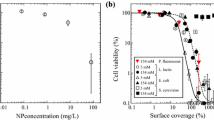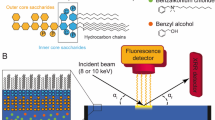Abstract
It has been previously shown that biological attachment mechanisms are supplemented by surface tension mediated attachment for pellicles formed by Pseudomonas aeruginosa. To further examine the role of surface tension on pellicle formation, non-ionic polyoxyethylene alcohol surfactants were added to growth media. Pellicle attachment and growth is delayed, and moduli are weakened when surfactant is added to growth media at concentrations close to and above the CMC. However, these effects are not primarily due to changes in surface tension. This can be observed by continuing modification of pellicle behavior above the CMC and distinct surfactants at identical surface tensions modifying pellicle moduli differently. Based on changes to bacteria wettability, it is determined that these surfactants modify pellicle formation by adsorbing to bacteria surfaces. Such adsorption is known to increase repulsive forces between gram negative bacteria like Pseudomonas Aeruginosa, which weakens aggregation between bacteria, affecting pellicle formation.






Similar content being viewed by others

References
Abbasnezhad H, Foght JM, Gray MR (2011) Adhesion to the hydrocarbon phase increases phenanthrene degradation by Pseudomonas fluorescens LP6a. Biodegradation 22:485–496
Andersson S, Kuttuva Rajarao G, Land CJ, Dalhammar G (2008) Biofilm formation and interactions of bacterial strains found in wastewater treatment systems. FEMS Microbiol Lett 283:83–90
Armitano J, Méjean V, Jourlin-Castelli C (2014) Gram-negative bacteria can also form pellicles. Environmental Microbiology Reports 6:534–544
Bachmann RT, Johnson AC, Edyvean RGJ (2014) Biotechnology in the petroleum industry: an overview. Int Biodeterior Biodegradation 86:225–237. https://doi.org/10.1016/j.ibiod.2013.09.011
Bajaj S, Singh DK (2015) Biodegradation of persistent organic pollutants in soil, water and pristine sites by cold-adapted microorganisms: mini review. Int Biodeterior Biodegradation 100:98–105. https://doi.org/10.1016/j.ibiod.2015.02.023
Berry JD, Neeson MJ, Dagastine RR, Chan DY, Tabor RF (2015) Measurement of surface and interfacial tension using pendant drop tensiometry. J Colloid Interface Sci 454:226–237
Branda SS, Vik Å, Friedman L, Kolter R (2005) Biofilms: the matrix revisited. Trends Microbiol 13:20–26
Brooijmans RJ, Pastink MI, Siezen RJ (2009) Hydrocarbon-degrading bacteria: the oil-spill clean-up crew. Microb Biotechnol 2:587–594
Brooks JD, Flint SH (2008) Biofilms in the food industry: problems and potential solutions. Int J Food Sci Technol 43:2163–2176
Brown DG, Al Nuaimi KS (2005) Nonionic surfactant sorption onto the bacterial cell surface: a multi-interaction isotherm. Langmuir 21:11368–11372
Brown DG, Jaffé PR (2006) Effects of nonionic surfactants on the cell surface hydrophobicity and apparent Hamaker constant of a Sphingomonas sp. Environ Sci Technol 40:195–201. https://doi.org/10.1021/es051183y
Das N, Chandran P (2011) Microbial degradation of petroleum hydrocarbon contaminants: an overview. Biotechnology research international 2011
Davies D (2003) Understanding biofilm resistance to antibacterial agents. Nat Rev Drug Discovery 2:114–122
Eastoe J, Dalton JS, Rogueda PGA, Crooks ER, Pitt AR, Simister EA (1997) Dynamic surface tensions of nonionic surfactant solutions. J Colloid Interface Sci 188:423–430
Flemming H-C (2002) Biofouling in water systems–cases, causes and countermeasures. Appl Microbiol Biotechnol 59:629–640
Flemming H-C, Wingender J (2010) The Biofilm Matrix Nature Reviews Microbiology 8:623–633
Flemming H-C, Wingender J, Szewzyk U, Steinberg P, Rice SA, Kjelleberg S (2016) Biofilms: an emergent form of bacterial life. Nat Rev Microbiol 14:563
Fuentes S, Mendez V, Aguila P, Seeger M (2014) Bioremediation of petroleum hydrocarbons: catabolic genes, microbial communities, and applications. Appl Microbiol Biotechnol 98:4781–4794. https://doi.org/10.1007/s00253-014-5684-9
Hollenbeck EC, Fong JC, Lim JY, Yildiz FH, Fuller GG, Cegelski L (2014) Molecular determinants of mechanical properties of V. cholerae biofilms at the air-liquid interface. Biophys J 107:2245–2252. https://doi.org/10.1016/j.bpj.2014.10.015
Houari A, Picard J, Habarou H, Galas L, Vaudry H, Heim V, Di Martino P (2008) Rheology of biofilms formed at the surface of NF membranes in a drinking water production unit. Biofouling 24:235–240
Hu G, Li J, Zeng G (2013) Recent development in the treatment of oily sludge from petroleum industry: a review. J Hazard Mater 261:470–490
Kim JK, Rühs PA, Fischer P, Hong JS (2013) Interfacial localization of nanoclay particles in oil-in-water emulsions and its reflection in interfacial moduli. Rheol Acta 52:327–335
King GM, Kostka JE, Hazen TC, Sobecky PA (2015) Microbial responses to the deepwater horizon oil spill: from coastal wetlands to the deep sea. Ann Rev Mar Sci 7:377–401. https://doi.org/10.1146/annurev-marine-010814-015543
Klapper I, Dockery J (2010) Mathematical description of microbial biofilms. SIAM Rev 52:221–265
Klapper I, Rupp CJ, Cargo R, Purvedorj B, Stoodley P (2002) Viscoelastic fluid description of bacterial biofilm material properties. Biotechnology Bioengineering 80:289–296
Koza A, Hallett PD, Moon CD, Spiers AJ (2009) Characterization of a novel air–liquid interface biofilm of Pseudomonas fluorescens SBW25. Microbiology 155:1397–1406. https://doi.org/10.1099/mic.0.025064-0
Lin S-Y, Lin Y-Y, Chen E-M, Hsu C-T, Kwan C-C (1999) A study of the equilibrium surface tension and the critical micelle concentration of mixed surfactant solutions. Langmuir 15:4370–4376
Mahapatra A, Padhi N, Mahapatra D, Bhatt M, Sahoo D, Jena S, Dash D, Chayani N (2015) Study of biofilm in bacteria from water pipelines. Journal of Clinical and Diagnostic Research: JCDR 9: DC09
Morse M, Huang A, Li G, Maxey MR, Tang JX (2013) Molecular adsorption steers bacterial swimming at the air/water interface. Biophys J 105:21–28. https://doi.org/10.1016/j.bpj.2013.05.026
Nielsen CK, Kjems J, Mygind T, Snabe T, Meyer RL (2016) Effects of Tween 80 on growth and biofilm formation in laboratory media. Front Microbiol 7:1878
Qi L, Christopher GF (2019) Role of flagella, type IV pili, biosurfactants, and extracellular polymeric substance polysaccharides on the formation of pellicles by Pseudomonas aeruginosa. Langmuir 35:5294–5304
Qi L, Christopher GF (2021) Rheological variability of Pseudomonas aeruginosa biofilms. Rheol Acta 60:219–230
Rosenberg E, Balows A, Truper H, Dworkin M, Harder W, Schleifer K (1992) The hydrocarbon-oxidizing bacteria. The Prokaryotes: a Handbook on the Biology of Bacteria: Ecophysiology, Isolation, Identification, Applications I:446–459
Rühs PA, Böcker L, Inglis RF, Fischer P (2014) Studying bacterial hydrophobicity and biofilm formation at liquid–liquid interfaces through interfacial rheology and pendant drop tensiometry. Colloids Surf, B 117:174–184
Rühs PA, Böni L, Fuller GG, Inglis RF, Fischer P (2013) In-situ quantification of the interfacial rheological response of bacterial biofilms to environmental stimuli. PLoS One 8:e78524
Schroyen B, Gunes DZ, Vermant J (2017) A versatile subphase exchange cell for interfacial shear rheology. Rheol Acta 56:1–10
Schultz M, Bendick J, Holm E, Hertel W (2011) Economic impact of biofouling on a naval surface ship. Biofouling 27:87–98
Shaw T, Winston M, Rupp CJ, Klapper I, Stoodley P (2004) Commonality of elastic relaxation times in biofilms. Phys Rev Lett 93:098102
Sloup RE, Cieza RJ, Needle DB, Abramovitch RB, Torres AG, Waters CM (2016) Polysorbates prevent biofilm formation and pathogenesis of Escherichia coli O104:H4. Biofouling 32:1131–1140. https://doi.org/10.1080/08927014.2016.1230849
Toutain-Kidd CM, Kadivar SC, Bramante CT, Bobin SA, Zegans ME (2009) Polysorbate 80 inhibition of Pseudomonas aeruginosa biofilm formation and its cleavage by the secreted lipase LipA. Antimicrob Agents Chemother 53:136–145
Vaccari L, Allan DB, Sharifi-Mood N, Singh AR, Leheny RL, Stebe KJ (2015) Films of bacteria at interfaces: three stages of behaviour. Soft Matter 11:6062–6074
Van Houdt R, Michiels C (2010) Biofilm formation and the food industry, a focus on the bacterial outer surface. J Appl Microbiol 109:1117–1131
Vandebril S, Franck A, Fuller GG, Moldenaers P, Vermant J (2010) A double wall-ring geometry for interfacial shear rheometry. Rheol Acta 49:131–144
Vargaftik N, Volkov B, Voljak L (1983) International tables of the surface tension of water. J Phys Chem Ref Data 12:817–820
Vasiljević J, Simončič B, Kert M (2015) The influence of a surfactant’s structure and the mode of its action during reactive wool dyeing. Tekstilec 58:301–313. https://doi.org/10.14502/Tekstilec2015.58.301-313
Wilking JN, Angelini TE, Seminara A, Brenner MP, Weitz DA (2011) Biofilms as Complex Fluids MRS Bulletin 36:385
Wingender J, Neu TR, Flemming H-C (1999) What are bacterial extracellular polymeric substances?Microbial extracellular polymeric substances. Springer, pp 1–19
Wu C, Lim JY, Fuller GG, Cegelski L (2013) Disruption of Escherichia coli amyloid-integrated biofilm formation at the air–liquid interface by a polysorbate surfactant. Langmuir 29:920–926
Zhang Z, Christopher G (2016) Effect of particulate contaminants on the development of biofilms at air/water interfaces. Langmuir 32:2724–2730
Acknowledgements
We wish to acknowledge the NSF CMMI for funding this work (#1635245). The authors would also like to thank Dr. Michael San Francisco of TTU, Dr. Kendra Rumbaugh of TTU HSC, and Dr. Vernita Gordon of UT for all their help in supplying bacteria, educating the authors in bacteria culturing technique, and a wide range of useful discussions.
Author information
Authors and Affiliations
Corresponding author
Additional information
Publisher's Note
Springer Nature remains neutral with regard to jurisdictional claims in published maps and institutional affiliations.
Supplementary Information
Below is the link to the electronic supplementary material.
Rights and permissions
About this article
Cite this article
Qi, L., Christopher, G.F. Effects of non-ionic surfactant on the formation of pellicles by Pseudomonas aeruginosa. Rheol Acta 61, 59–68 (2022). https://doi.org/10.1007/s00397-021-01313-0
Received:
Revised:
Accepted:
Published:
Issue Date:
DOI: https://doi.org/10.1007/s00397-021-01313-0



